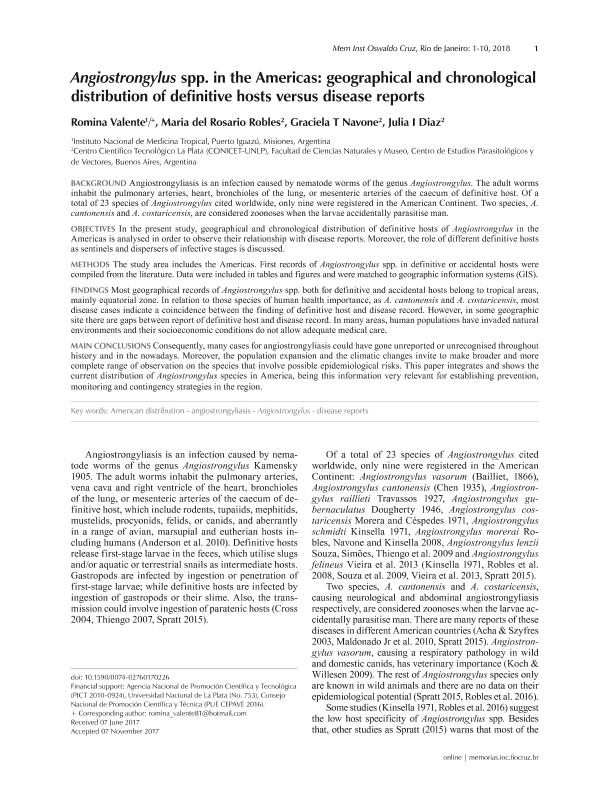Mostrar el registro sencillo del ítem
dc.contributor.author
Valente, Romina

dc.contributor.author
Robles, Maria del Rosario

dc.contributor.author
Navone, Graciela Teresa

dc.contributor.author
Diaz, Julia Inés

dc.date.available
2019-10-08T21:00:19Z
dc.date.issued
2018-03
dc.identifier.citation
Valente, Romina; Robles, Maria del Rosario; Navone, Graciela Teresa; Diaz, Julia Inés; Angiostrongylus spp. In the Americas: Geographical and chronological distribution of definitive hosts versus disease reports; Fundação Oswaldo Cruz; Memórias do Instituto Oswaldo Cruz; 113; 3; 3-2018; 143-152
dc.identifier.issn
0074-0276
dc.identifier.uri
http://hdl.handle.net/11336/85399
dc.description.abstract
BACKGROUND: Angiostrongyliasis is an infection caused by nematode worms of the genus Angiostrongylus. The adult worms inhabit the pulmonary arteries, heart, bronchioles of the lung, or mesenteric arteries of the caecum of definitive host. Of a total of 23 species of Angiostrongylus cited worldwide, only nine were registered in the American Continent. Two species, A. cantonensis and A. costaricensis, are considered zoonoses when the larvae accidentally parasitise man. OBJECTIVES: In the present study, geographical and chronological distribution of definitive hosts of Angiostrongylus in the Americas is analysed in order to observe their relationship with disease reports. Moreover, the role of different definitive hosts as sentinels and dispersers of infective stages is discussed. METHODS: The study area includes the Americas. First records of Angiostrongylus spp. in definitive or accidental hosts were compiled from the literature. Data were included in tables and figures and were matched to geographic information systems (GIS). FINDINGS: Most geographical records of Angiostrongylus spp. both for definitive and accidental hosts belong to tropical areas, mainly equatorial zone. In relation to those species of human health importance, as A. cantonensis and A. costaricensis, most disease cases indicate a coincidence between the finding of definitive host and disease record. However, in some geographic site there are gaps between report of definitive host and disease record. In many areas, human populations have invaded natural environments and their socioeconomic conditions do not allow adequate medical care. MAIN CONCLUSIONS: Consequently, many cases for angiostrongyliasis could have gone unreported or unrecognised throughout history and in the nowadays. Moreover, the population expansion and the climatic changes invite to make broader and more complete range of observation on the species that involve possible epidemiological risks. This paper integrates and shows the current distribution of Angiostrongylus species in America, being this information very relevant for establishing prevention, monitoring and contingency strategies in the region.
dc.format
application/pdf
dc.language.iso
eng
dc.publisher
Fundação Oswaldo Cruz

dc.rights
info:eu-repo/semantics/openAccess
dc.rights.uri
https://creativecommons.org/licenses/by/2.5/ar/
dc.subject
AMERICAN DISTRIBUTION
dc.subject
ANGIOSTRONGYLIASIS
dc.subject
ANGIOSTRONGYLUS
dc.subject
DISEASE REPORTS
dc.subject.classification
Zoología, Ornitología, Entomología, Etología

dc.subject.classification
Ciencias Biológicas

dc.subject.classification
CIENCIAS NATURALES Y EXACTAS

dc.title
Angiostrongylus spp. In the Americas: Geographical and chronological distribution of definitive hosts versus disease reports
dc.type
info:eu-repo/semantics/article
dc.type
info:ar-repo/semantics/artículo
dc.type
info:eu-repo/semantics/publishedVersion
dc.date.updated
2019-09-27T14:52:34Z
dc.identifier.eissn
1678-8060
dc.journal.volume
113
dc.journal.number
3
dc.journal.pagination
143-152
dc.journal.pais
Brasil

dc.journal.ciudad
San Pablo
dc.description.fil
Fil: Valente, Romina. Consejo Nacional de Investigaciones Científicas y Técnicas. Centro Científico Tecnológico Conicet - Nordeste; Argentina. Ministerio de Salud. Instituto Nacional de Medicina Tropical; Argentina
dc.description.fil
Fil: Robles, Maria del Rosario. Consejo Nacional de Investigaciones Científicas y Técnicas. Centro Científico Tecnológico Conicet - La Plata. Centro de Estudios Parasitológicos y de Vectores. Universidad Nacional de La Plata. Facultad de Ciencias Naturales y Museo. Centro de Estudios Parasitológicos y de Vectores; Argentina
dc.description.fil
Fil: Navone, Graciela Teresa. Consejo Nacional de Investigaciones Científicas y Técnicas. Centro Científico Tecnológico Conicet - La Plata. Centro de Estudios Parasitológicos y de Vectores. Universidad Nacional de La Plata. Facultad de Ciencias Naturales y Museo. Centro de Estudios Parasitológicos y de Vectores; Argentina
dc.description.fil
Fil: Diaz, Julia Inés. Consejo Nacional de Investigaciones Científicas y Técnicas. Centro Científico Tecnológico Conicet - La Plata. Centro de Estudios Parasitológicos y de Vectores. Universidad Nacional de La Plata. Facultad de Ciencias Naturales y Museo. Centro de Estudios Parasitológicos y de Vectores; Argentina
dc.journal.title
Memórias do Instituto Oswaldo Cruz

dc.relation.alternativeid
info:eu-repo/semantics/altIdentifier/url/http://ref.scielo.org/nvmw4z
dc.relation.alternativeid
info:eu-repo/semantics/altIdentifier/doi/http://dx.doi.org/10.1590/0074-02760170226
dc.relation.alternativeid
info:eu-repo/semantics/altIdentifier/url/https://bit.ly/30WnXvy
Archivos asociados
